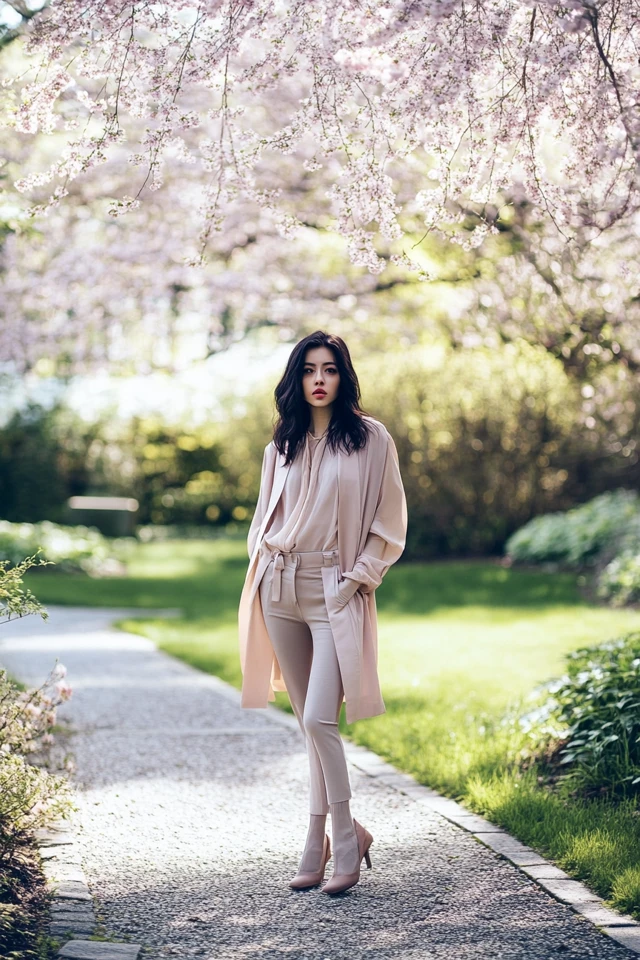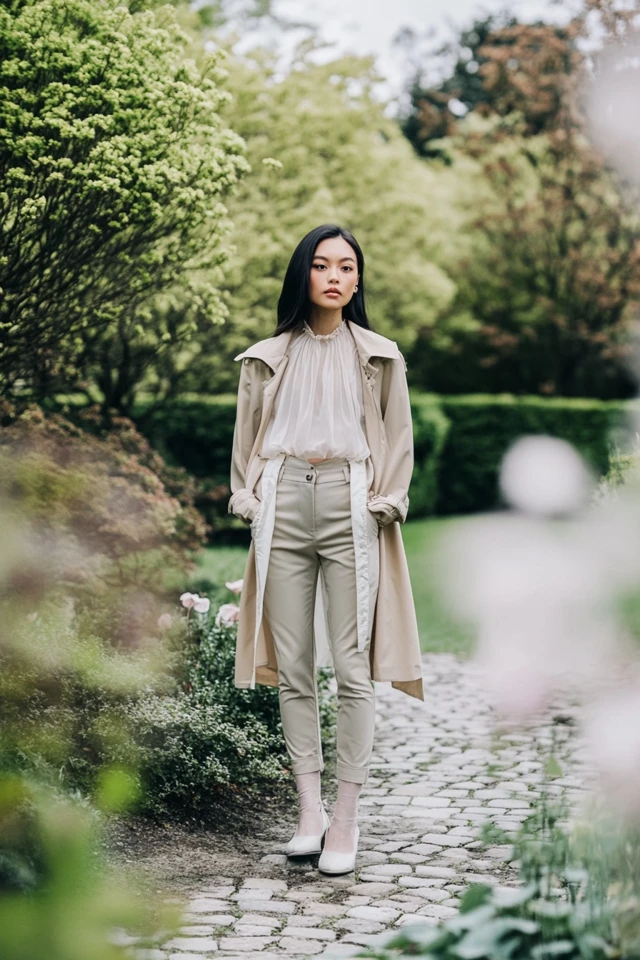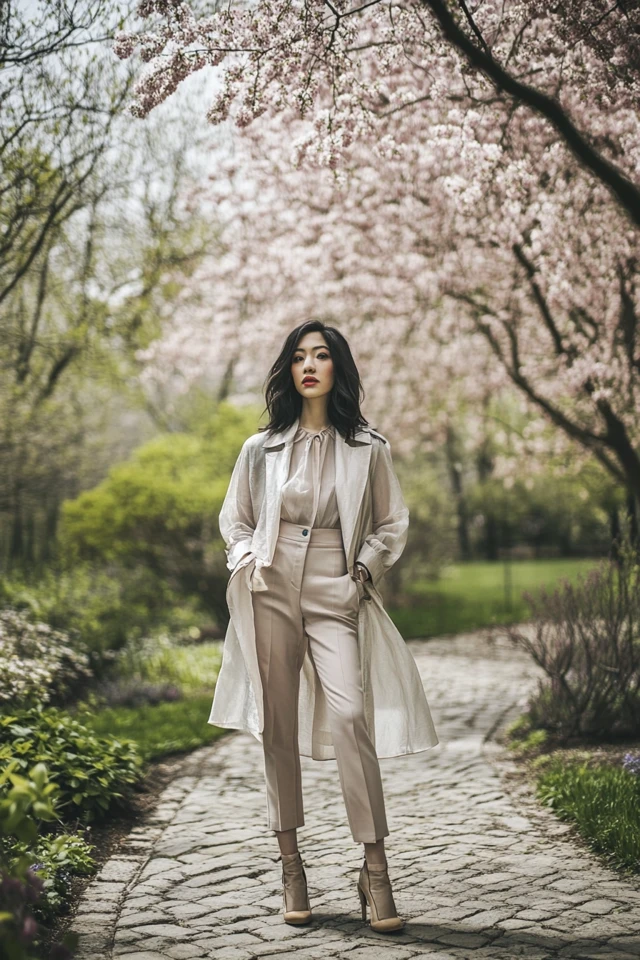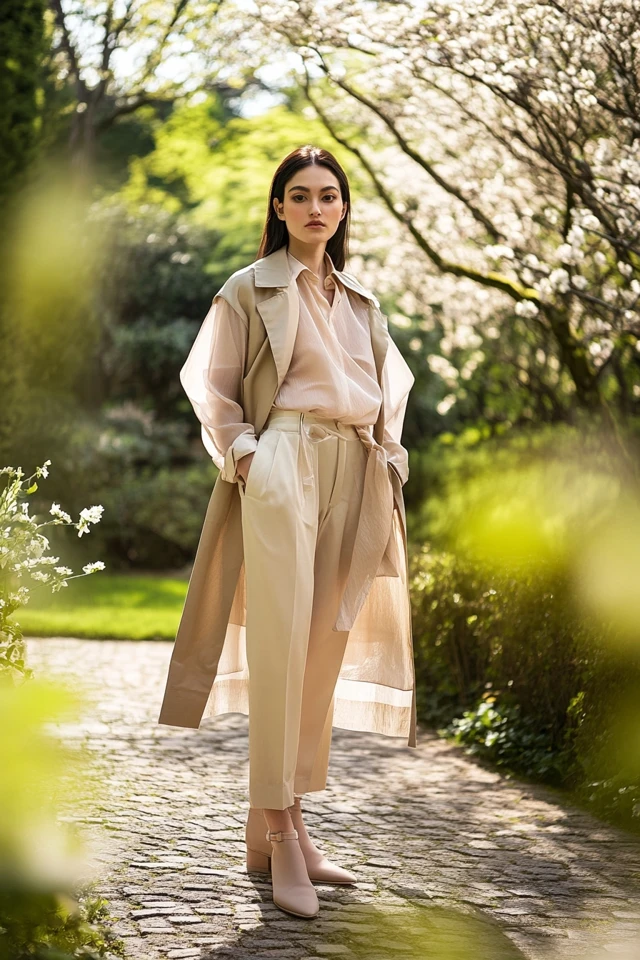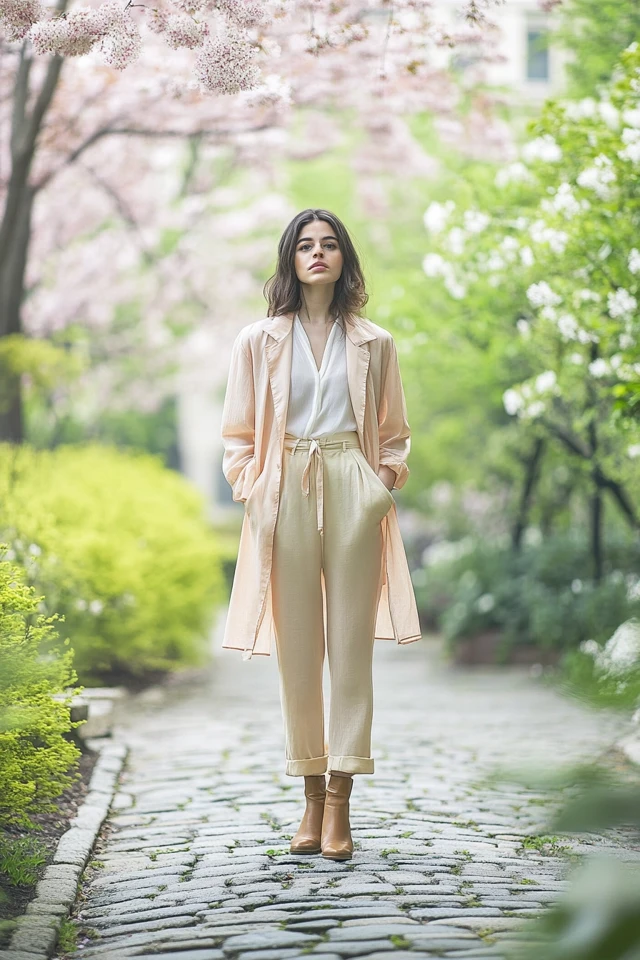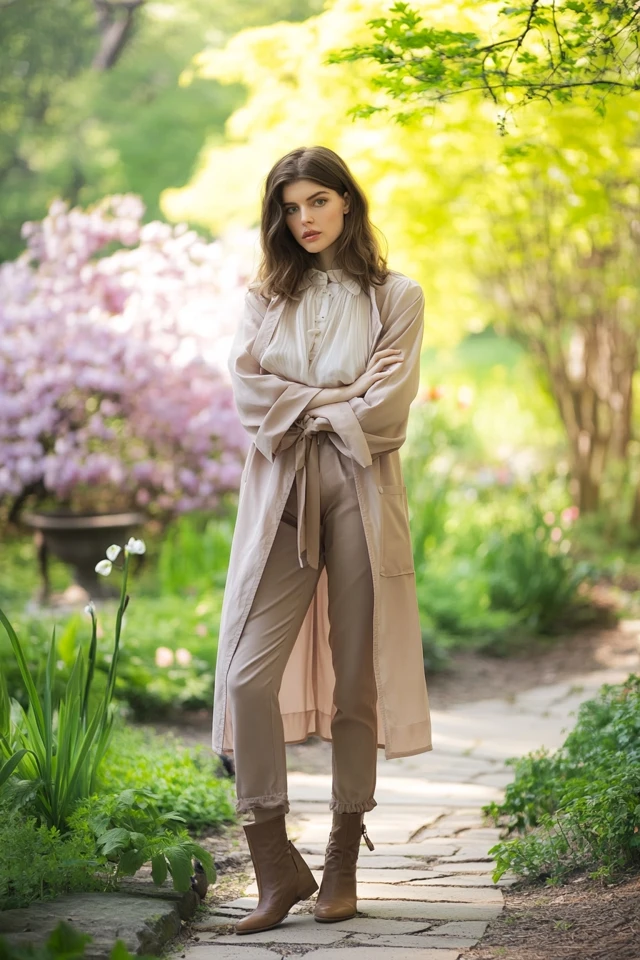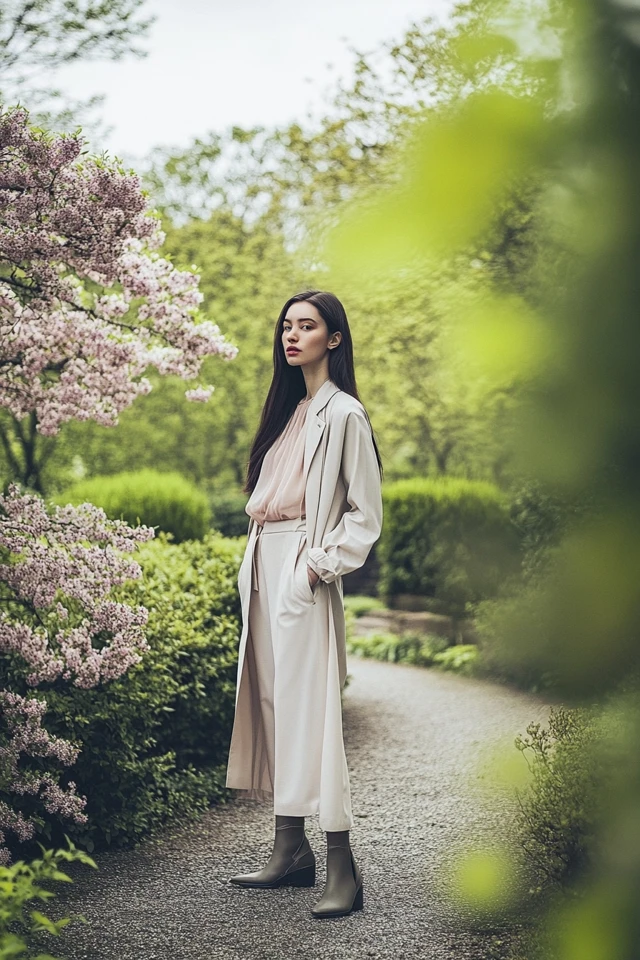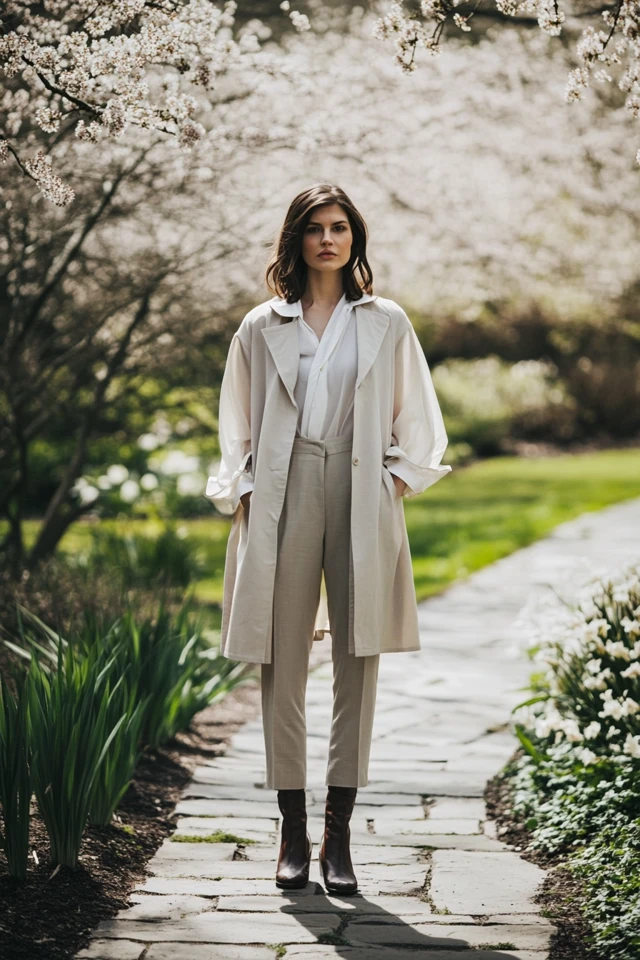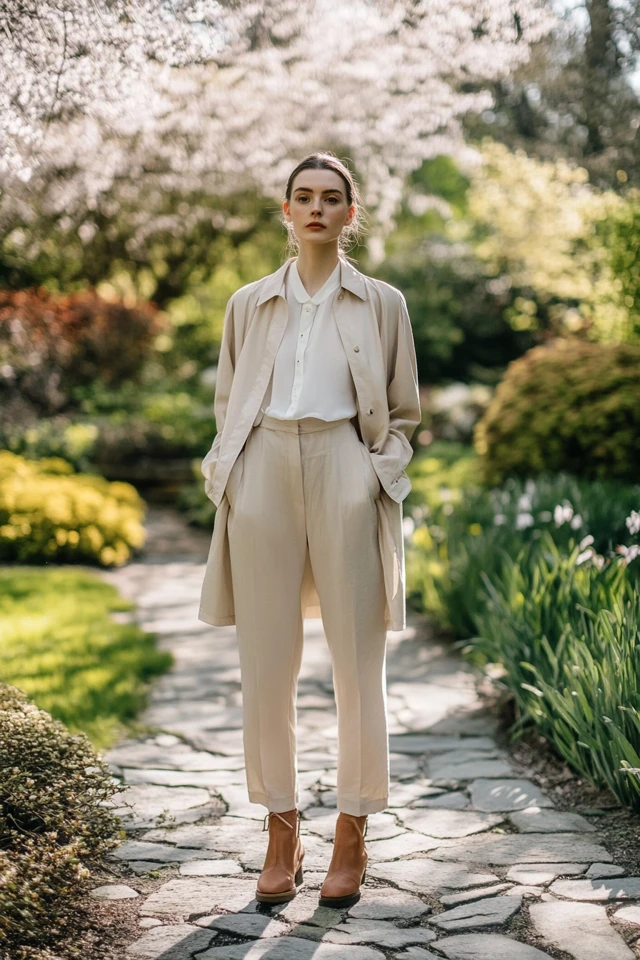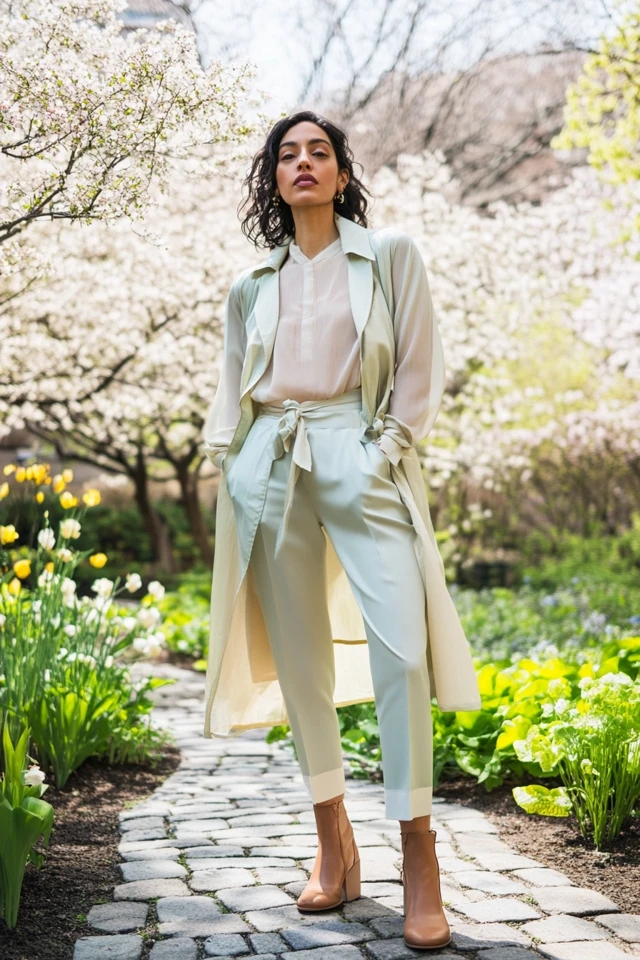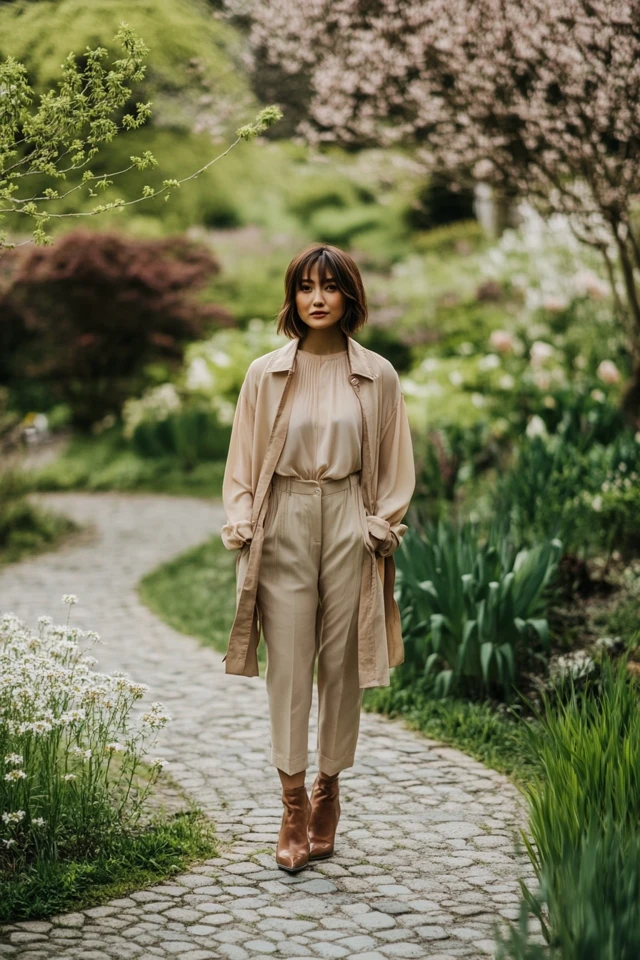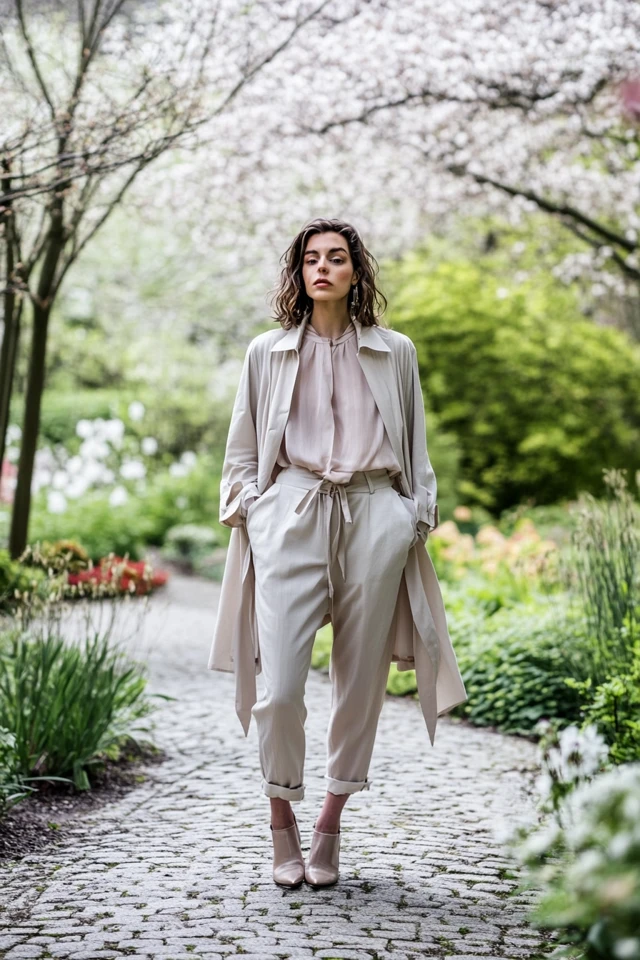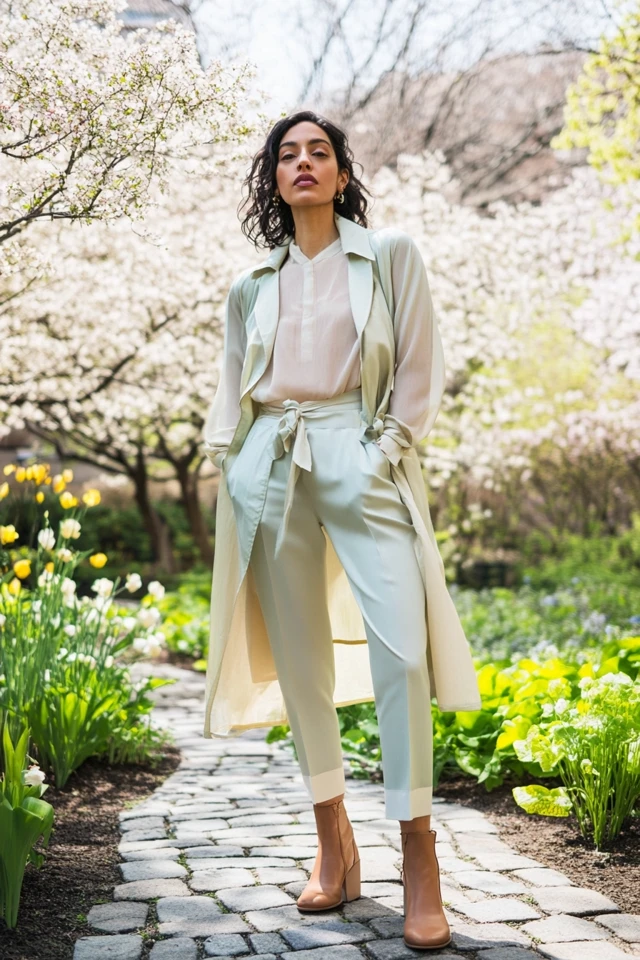Spring is a season of transition, where unpredictable weather can range from sunny and warm to chilly and rainy within the same day. Mastering the art of layering with light fabrics is essential to stay comfortable and stylish during these fluctuating conditions. By strategically combining various lightweight materials, you can create versatile outfits that adapt seamlessly to changing temperatures and unexpected weather shifts. This guide explores the principles of effective spring layering, highlights essential light fabrics, offers practical styling tips, and provides advice to help you navigate the unpredictable spring climate with confidence and elegance.
Introduction
As winter fades away and spring emerges, the wardrobe undergoes a significant transformation. The need for bulky winter coats diminishes, but the unpredictability of spring weather demands a more flexible and adaptable approach to dressing. Layering with light fabrics allows you to add or remove pieces effortlessly, ensuring that you remain comfortable throughout the day regardless of temperature changes. Additionally, layering enhances your outfit’s depth and texture, contributing to a more polished and stylish appearance. Whether you’re enjoying a sunny morning or braving a sudden spring shower, mastering layering techniques with lightweight materials is key to maintaining both functionality and fashion-forwardness.
About the Author and My Trend Boutique
The Importance of Layering in Spring
Adapting to Temperature Fluctuations
Spring weather is notoriously inconsistent, with temperatures often swinging between warm and cool within hours. Layering provides the flexibility to adjust your outfit accordingly:
- Morning Chill: Start with a light base layer to keep warm during cooler early hours.
- Afternoon Warmth: Easily shed or adjust layers as the day heats up.
- Evening Cool: Add an extra layer to stay cozy when temperatures drop again.
Enhancing Style and Depth
Layering allows you to play with different textures, colors, and patterns, adding visual interest and complexity to your outfits:
- Texture Contrast: Combine smooth fabrics like cotton with textured materials like knitwear or denim.
- Color Coordination: Layer complementary or contrasting colors to create a cohesive and dynamic look.
- Pattern Mixing: Experiment with mixing patterns, such as stripes with florals, to achieve a balanced and stylish ensemble.
Increasing Outfit Versatility
With a well-layered wardrobe, a single outfit can be transformed multiple ways, making it suitable for various occasions and settings:
- Day to Night Transition: Add a blazer or scarf to shift a daytime outfit into evening-appropriate attire.
- Casual to Formal: Layer a cardigan or lightweight jacket over a blouse and jeans for a casual look, or over a dress and tailored pants for a more formal appearance.
Essential Light Fabrics for Spring Layering
Choosing the right fabrics is crucial for effective layering. Lightweight materials that offer breathability, flexibility, and comfort are ideal for spring:
1. Cotton
Description: Cotton is a versatile, breathable fabric that is perfect for spring layering. It is soft, comfortable, and easy to care for.
Why It’s Essential:
- Breathability: Allows air circulation, keeping you cool during warmer parts of the day.
- Versatility: Can be used for base layers, tops, and lightweight jackets.
- Durability: Stands up well to regular wear and washing.
2. Linen
Description: Linen is a natural fiber known for its lightweight and breathable properties. It has a relaxed, casual aesthetic that is perfect for spring.
Why It’s Essential:
- Cooling Effect: Highly breathable, ideal for maintaining comfort in varying temperatures.
- Texture: Adds a unique, slightly textured look to outfits.
- Natural Appearance: Offers a timeless, effortless style that complements layered looks.
3. Silk
Description: Silk is a luxurious, lightweight fabric that drapes beautifully and feels soft against the skin.
Why It’s Essential:
- Elegance: Adds a touch of sophistication to any layered outfit.
- Versatility: Can be used as a base layer or a statement piece.
- Comfort: Smooth texture prevents irritation when layered with other fabrics.
4. Rayon
Description: Rayon is a semi-synthetic fabric that mimics the feel of natural fibers like silk and cotton. It is lightweight, breathable, and easy to style.
Why It’s Essential:
- Flowy Fit: Ideal for creating relaxed, draped layers.
- Color Vibrancy: Holds dyes well, making it perfect for adding pops of color to your outfits.
- Affordability: Often more budget-friendly than natural fabrics without sacrificing style.
5. Chambray
Description: Chambray is a lightweight fabric that resembles denim but is more breathable and softer.
Why It’s Essential:
- Casual Chic: Perfect for creating laid-back yet stylish layered looks.
- Durability: Maintains its shape and color over time.
- Ease of Pairing: Combines well with a variety of colors and patterns.
Essential Pieces for Spring Layering
Building a versatile spring layering wardrobe involves selecting key pieces that can be mixed and matched effortlessly. Here are the essentials:
1. Base Layers
Examples:
- Basic Tees: Solid colors or subtle patterns.
- Tank Tops: Lightweight and perfect for layering.
- Long-Sleeve Shirts: Provide additional coverage and warmth.
Styling Tips:
- Neutral Colors: Start with neutral shades like white, beige, gray, and navy for maximum versatility.
- Fit: Choose well-fitting base layers that aren’t too bulky, allowing for comfortable layering.
2. Lightweight Sweaters and Cardigans
Examples:
- Crew-Neck Sweaters: Classic and easy to pair with various outfits.
- Cardigans: Button-up or open-front styles for different looks.
- V-Neck Sweaters: Ideal for showcasing layered shirts or necklaces.
Styling Tips:
- Texture Mixing: Combine different textures, such as a chunky knit cardigan with a smooth silk blouse.
- Color Coordination: Layer sweaters in complementary or contrasting colors to add depth to your outfit.
3. Lightweight Jackets and Blazers
Examples:
- Denim Jackets: Casual and versatile.
- Trench Coats: Timeless and elegant.
- Blazers: Perfect for a polished, professional look.
Styling Tips:
- Layering Order: Wear jackets over sweaters and under heavier coats if needed.
- Proportions: Balance fitted jackets with flowy tops or skirts to create a flattering silhouette.
4. Versatile Dresses and Skirts
Examples:
- Midi Dresses: Comfortable and stylish for various occasions.
- A-Line Skirts: Flattering on many body types and easy to layer with tights or leggings.
- Wrap Dresses: Adjustable and flattering, suitable for both casual and formal settings.
Styling Tips:
- Layer with Tops: Wear a fitted top or turtleneck underneath dresses for added warmth.
- Accessorize: Add belts or scarves to personalize and enhance your layered look.
5. Bottoms
Examples:
- Lightweight Trousers: Chinos, tailored pants, or wide-leg styles.
- Jeans: Versatile and durable for casual layering.
- Leggings: Comfortable and perfect for pairing with longer tops or dresses.
Styling Tips:
- Mix and Match: Combine different bottoms with various tops and jackets to create multiple outfits.
- Color Coordination: Stick to a cohesive color palette to ensure all pieces work well together.
Practical Styling Tips for Spring Layering
1. Embrace Layering Diversity
Combine different types of layers to add complexity and interest to your outfits:
- Base Layer + Middle Layer + Outer Layer: For example, a tank top under a long-sleeve shirt, topped with a cardigan and a lightweight jacket.
- Mix of Fabrics: Pair smooth fabrics like silk with textured ones like knitwear to create a balanced look.
2. Play with Proportions
Balancing different lengths and fits can enhance your overall silhouette:
- Fitted Tops with Flowy Bottoms: Create a flattering contrast by pairing a snug sweater with an A-line skirt.
- Oversized Layers with Tailored Pieces: Offset bulky cardigans with slim-fit trousers or skirts for a stylish balance.
3. Utilize Accessories
Accessories can elevate your layered outfits and add personal flair:
- Scarves: Add color and texture while providing warmth.
- Belts: Define your waist and add structure to loose-fitting layers.
- Jewelry: Statement necklaces or delicate earrings can enhance your look without adding bulk.
4. Incorporate Patterns and Prints
Adding patterns can break up the monotony of solid colors and add visual interest:
- Stripes and Checks: Versatile patterns that can be mixed with solids.
- Floral Prints: Perfect for adding a touch of spring freshness to your layers.
- Geometric Patterns: Modern and stylish, ideal for creating dynamic outfits.
5. Opt for Versatile Colors
Choose a color palette that allows for maximum mixing and matching:
- Neutrals with Pops of Color: Base your layers on neutrals and add pops of color through specific pieces.
- Complementary Colors: Use the color wheel to find complementary hues that enhance each other.
- Monochromatic Schemes: Stick to different shades of the same color for a cohesive and sophisticated look.
6. Prioritize Comfort and Functionality
Ensure that your layered outfits are not only stylish but also comfortable and practical:
- Breathable Fabrics: Choose materials that allow for airflow and prevent overheating.
- Ease of Movement: Avoid overly bulky layers that restrict movement.
- Weather Adaptability: Select layers that can be easily added or removed as the weather changes.
Essential Accessories for Spring Layering
1. Lightweight Scarves
Description: Scarves are versatile accessories that can add warmth, style, and color to your layered outfits.
Styling Tips:
- Knotted Styles: Tie a scarf in a classic knot or drape it loosely around your neck.
- Wrapped Around the Bag: Add a scarf as a stylish detail to your handbag.
- Tied to the Belt: Use a scarf as a belt to cinch dresses or oversized sweaters.
2. Fedoras and Wide-Brimmed Hats
Description: Hats not only protect you from the elements but also add a chic touch to your spring outfits.
Styling Tips:
- Pair with Dresses: Complement midi and maxi dresses with a stylish fedora.
- Casual Looks: Add a beanie or a casual cap to jeans and sweaters for a relaxed vibe.
- Structured Silhouettes: Choose hats with structured designs to balance flowy layers.
3. Belts
Description: Belts define your waist and add structure to your outfits, making them essential for layered looks.
Styling Tips:
- Statement Belts: Use bold-colored or embellished belts to add a focal point.
- Classic Leather Belts: Opt for neutral-toned belts for versatility.
- Layered Belts: Combine multiple belts for a unique and personalized style.
4. Jewelry
Description: Jewelry can enhance your layered outfits by adding sparkle, color, and personal flair.
Styling Tips:
- Layered Necklaces: Combine different lengths and styles of necklaces for a trendy look.
- Statement Earrings: Add bold earrings to draw attention to your face.
- Bracelets and Rings: Stack bracelets and rings to complement your layers without adding bulk.
5. Bags
Description: The right bag can complete your layered outfit while providing functionality.
Styling Tips:
- Crossbody Bags: Practical and stylish, perfect for hands-free layering.
- Totes and Shoulder Bags: Offer ample space for essentials and can be easily paired with various outfits.
- Clutches: Ideal for evening layers, adding a touch of elegance without bulk.
Practical Advice for Maintaining Layered Outfits
1. Organize Your Closet
- Categorize by Layer: Arrange your clothes by base layers, middle layers, and outer layers for easy access.
- Color Coordination: Group similar colors together to simplify mixing and matching.
- Seasonal Rotation: Rotate your layers based on the season to keep your wardrobe current and organized.
2. Invest in Quality Basics
- Timeless Pieces: Prioritize high-quality, timeless basics that form the foundation of your layered outfits.
- Versatile Items: Choose pieces that can be easily integrated with various layers and styles.
3. Experiment with Different Combinations
- Try New Styles: Don’t be afraid to experiment with different layering combinations to discover what works best for your body type and personal style.
- Mix Textures and Patterns: Play with different textures and patterns to create unique and interesting looks.
4. Stay Prepared for Weather Changes
- Carry a Lightweight Jacket: Always have a lightweight jacket or blazer in your bag for unexpected drops in temperature.
- Layering on the Go: Utilize accessories like scarves and hats that can be easily added or removed as needed.
5. Prioritize Comfort
- Fit and Movement: Ensure that your layers allow for comfortable movement without being too restrictive.
- Breathable Fabrics: Opt for fabrics that offer both warmth and breathability to prevent overheating.
Example Outfit Ideas
1. Casual Chic
Outfit Components:
- White long-sleeve tee
- Light gray cardigan
- Denim jeans
- Beige trench coat
- Patterned scarf
- White sneakers
Styling Tips:
- Layer the white tee under the gray cardigan for added warmth.
- Wear the trench coat for a polished and sophisticated touch.
- Add a patterned scarf to introduce a pop of color and texture.
- Complete the look with white sneakers for a comfortable and stylish ensemble.
2. Office Ready
Outfit Components:
- Silk blouse in a bold color (e.g., cobalt blue)
- Black tailored trousers
- Blazer in a neutral shade
- Statement necklace
- Black ankle boots
- Structured handbag
Styling Tips:
- Layer the blazer over the silk blouse for a professional appearance.
- Pair with black tailored trousers for a sleek silhouette.
- Accessorize with a statement necklace to add a focal point to the outfit.
- Complete the look with black ankle boots and a structured handbag for a cohesive and elegant ensemble.
3. Weekend Comfort
Outfit Components:
- Striped long-sleeve top
- Oversized knit sweater
- High-waisted leggings
- Denim jacket
- Beanie
- Slip-on loafers
Styling Tips:
- Layer the striped top under the oversized sweater for added warmth and style.
- Wear high-waisted leggings for comfort and a flattering fit.
- Add a denim jacket for a casual and versatile layer.
- Complete the look with a cozy beanie and slip-on loafers for effortless weekend style.
4. Date Night
Outfit Components:
- Black turtleneck
- A-line midi skirt
- Statement belt
- Lightweight faux leather jacket
- Heeled ankle boots
- Delicate jewelry
Styling Tips:
- Pair the black turtleneck with the A-line midi skirt for a flattering silhouette.
- Use a statement belt to define your waist and add interest.
- Layer with a lightweight faux leather jacket for an edgy touch.
- Complete the look with heeled ankle boots and delicate jewelry for a romantic and stylish ensemble.
5. Outdoor Adventure
Outfit Components:
- Thermal base layer
- Fleece-lined cardigan
- Cargo pants
- Waterproof lightweight jacket
- Scarf
- Hiking boots
Styling Tips:
- Start with a thermal base layer for warmth.
- Layer with a fleece-lined cardigan for additional insulation.
- Wear cargo pants for practicality and comfort during outdoor activities.
- Top with a waterproof lightweight jacket to protect against unexpected weather.
- Add a scarf for extra warmth and complete the look with sturdy hiking boots.
FAQs
1. How can I choose the right layers for unpredictable spring weather?
- Answer: Start with a versatile base layer made from breathable fabrics like cotton or linen. Add a middle layer such as a lightweight sweater or cardigan for added warmth. Top it off with a waterproof or windproof outer layer like a trench coat or lightweight jacket. This combination allows you to adjust your outfit easily by adding or removing layers as the weather changes.
2. What are some lightweight fabrics that work well for spring layering?
- Answer: Fabrics like cotton, linen, rayon, chambray, and silk are ideal for spring layering. These materials are breathable, comfortable, and easy to mix and match, making them perfect for adapting to varying temperatures and conditions.
3. How do I prevent my layered outfits from looking bulky?
- Answer: To avoid bulkiness, choose slim-fitting or tailored layers that complement each other without overlapping too much. Opt for lightweight fabrics that drape well and avoid overly chunky materials unless intentionally adding texture. Pay attention to proportions by balancing fitted and loose pieces to maintain a streamlined silhouette.
4. Can I incorporate prints and patterns into my layered spring outfits?
- Answer: Yes, incorporating prints and patterns can add visual interest to your layered outfits. Mix different patterns thoughtfully by choosing complementary or subtle designs that work well together. For example, pair a striped base layer with a floral cardigan or a patterned scarf to create a harmonious and stylish look.
5. What are some essential layering pieces every spring wardrobe should have?
- Answer: Essential layering pieces for spring include basic tees, long-sleeve shirts, lightweight sweaters or cardigans, denim or utility jackets, trench coats or lightweight raincoats, versatile scarves, and comfortable footwear like sneakers or ankle boots. These items provide the foundation for creating a variety of layered looks that can adapt to changing weather conditions.
Conclusion
Mastering the art of spring layering with light fabrics is key to navigating the season’s unpredictable weather while maintaining a stylish and comfortable wardrobe. By selecting versatile, high-quality pieces and understanding how to combine different layers effectively, you can create endless outfit possibilities that adapt seamlessly to temperature fluctuations and varying conditions. Embrace the diversity of textures, colors, and patterns to add depth and personality to your ensembles, ensuring that you remain both fashionable and functional throughout the spring months.
Investing in essential layering pieces and adopting practical styling techniques will not only enhance your personal style but also simplify your daily dressing routine. Whether you’re enjoying a sunny day, braving a spring rain shower, or experiencing a sudden cool breeze, your expertly layered outfits will keep you prepared and poised for any weather scenario. Embrace the beauty and versatility of spring layering, and enjoy a season of effortless elegance and adaptability.
Happy styling, and may your spring layers bring comfort, confidence, and countless fashionable looks to your wardrobe!
Picture Gallery
